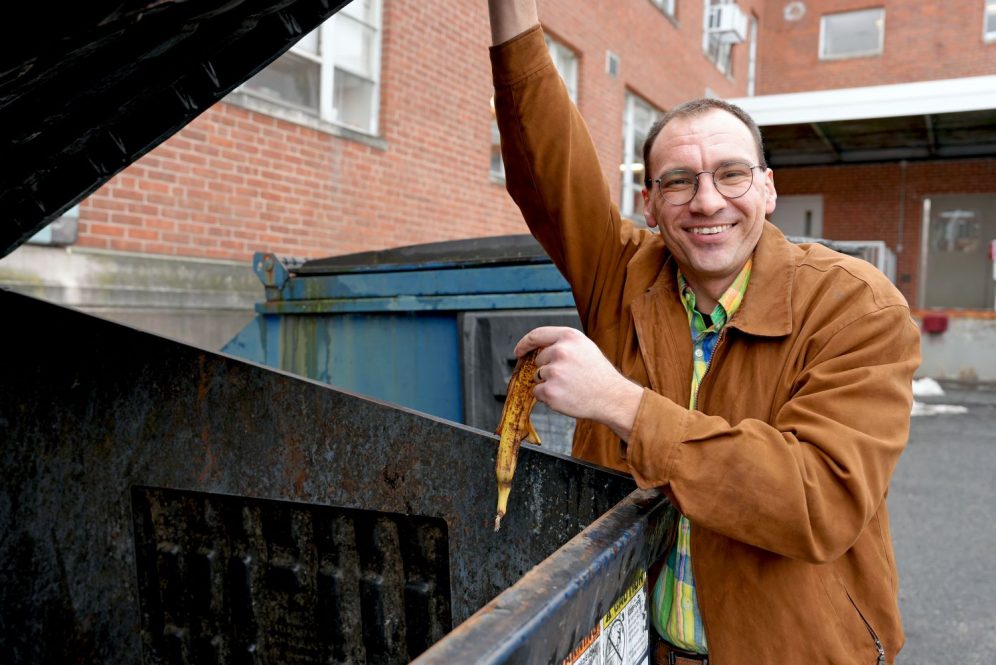A new UConn study explores the cost, effort, and impact of composting programs

Jackson Somers from the Department of Agricultural and Resource Economics is really excited about trash and what it can mean for a community's sustainability efforts. (Jason Sheldon/UConn Photo)
When you throw out food waste, even though it's organic material, it doesn't just harmlessly decompose at the landfill. This process releases methane. In a 20-year period, methane is 80-85 times more potent as a greenhouse gas than carbon dioxide.
This has led some municipalities to begin implementing composting programs as a way of reducing methane emissions.
When food waste is decomposing in a landfill, it rapidly uses up any available pockets of oxygen between the trash around it. This is an "aerobic" process, meaning it occurs in the presence of oxygen and produces carbon dioxide. But when that oxygen is used up, the waste begins decomposing through a longer "anerobic" process – meaning it occurs without oxygen – that produces methane.
Composting, on the other hand, is a fully aerobic process, and the resulting compost can be used as an agricultural fertilizer.
Decomposition in a landfill is an anerobic process, as food waste is jammed in with everything else at the dump, without room for oxygen to get in.
Jackson Somers, assistant professor of agricultural and resource economics in the College of Agriculture, Health and Natural Resources (CAHNR), investigated participation rates and the economics behind residential composting programs. Somers published his findings in the Journal of Environmental Economics and Management.
Somers found that on average, there is a 2.3-pound reduction in the amount of organic waste going into landfills per household per week when a city implements a composting program, using Austin, Texas as an example. This represents only about 30% of the average weekly food waste generated by a U.S. household.
Unlike some larger cities, like San Franciso, most composting programs, including Austin's, do not have any way to enforce compliance.
"As individuals, we produce a lot of food waste, and it's something we should be cognizant of. From there, you should compost if you want to compost," Somers says. "I think, inherently, we don't want to be wasteful. But for some people it's just a high burden of effort."
Somers found that, from a purely economic perspective, the cost to run a compost program outstrips the social cost of avoiding putting that methane into the atmosphere, especially with these low participation rates.
The "social cost of carbon" is a number economists use to estimate the financial cost of each additional ton of carbon dioxide emitted into the atmosphere. The current figure is pegged at $51. The median cost to expand composting programs is $478 per ton of CO2 avoided.
Large cities, which would be the largest methane emitters from organic waste, generally have methane capture technologies working at their landfills, some of which generate electricity or natural gas, while preventing methane from entering the atmosphere.
"With current programs, given the infrastructure we have - these programs are really expensive for the savings we see," Somers says.
However, this doesn't necessarily mean composting programs are never worth the investment.
As existing landfills fill up, it will be a major future expense to create new ones. So, creating a composting facility now may make economic and environmental sense in the long run.
Researchers are also constantly reevaluating the social cost of carbon. Generally, that cost increases as we learn more about the myriad impacts of greenhouse gas emissions and as these impacts accumulate.
"As we learn more about our impact, composting programs may become cheaper from an environmental sense," Somers says.
There may be other benefits for specific communities as well, such as reducing pests like rats that thrive on unsecured organic waste, especially in large cities like New York or Philadelphia.
"Keeping rats and other pests out of neighborhoods certainly goes into the calculus too," Somers says. "How many people get sick from rats? How much do we dislike seeing rats running around on the streets? It's important to factor in other impacts, not just environmental."
Somers emphasizes that questions about what to do with organic waste will differ from community to community.
In Connecticut, there are some curbside programs in cities. Others have drop-off programs where people collect food waste and bring it to a centralized location in places.
"A one-size-fits-all solution is not the answer," Somers says. "The solution in northwestern Connecticut is very different from the solution in Stamford or Hartford - and the solutions for Stamford and Hartford are also going to be different because demographically they're quite different."
Somers says that while his paper focused on single-family residential composting programs, there may be a larger impact on commercial waste from businesses like grocery stores.
"That's where I think you can see real savings," Somers says. "I think that's something we should consider more than we do."
This work relates to CAHNR's Strategic Vision area focused on Advancing Adaptation and Resilience in a Changing Climate.






